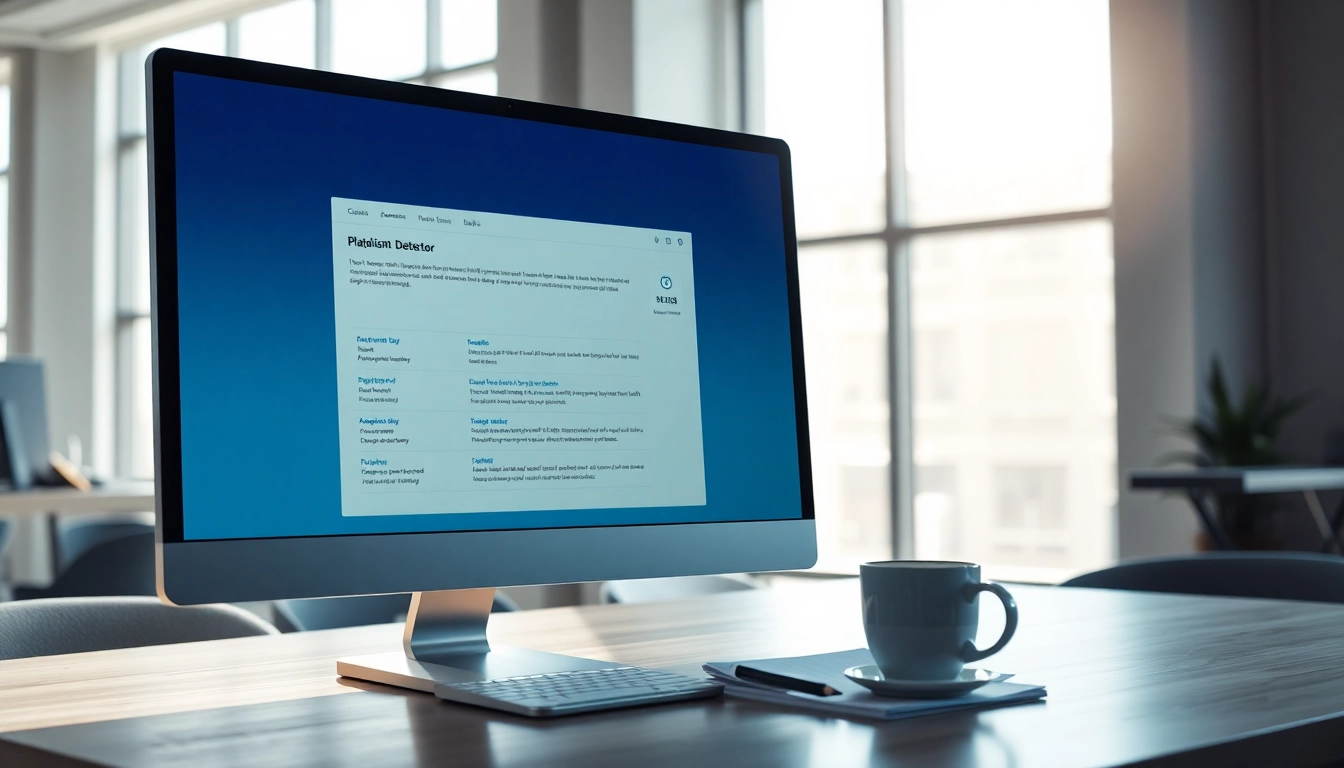Understanding Plagiarism Checkers
What is a plagiarism checker?
A plagiarism checker is a digital tool designed to examine written content and identify instances of plagiarism, which is the act of using someone else’s work or ideas without proper attribution. These tools are invaluable resources for students, educators, content creators, and professionals who wish to ensure the originality of their written materials. By comparing a submitted text against a vast database of documents, articles, and online content, a plagiarism checker can highlight copied passages and provide a percentage indicating the level of originality. In academic settings, the integrity of one’s work is paramount, making the use of a reliable plagiarism checker essential for maintaining scholarly standards.
How plagiarism checkers function
Plagiarism checkers primarily operate on algorithms that scan the submitted text against a set database. When a user uploads a document, the checker breaks the text down into smaller phrases or strings and matches them with previously indexed content across the internet and other sources. Many advanced plagiarism detection tools now incorporate machine learning, allowing them to recognize paraphrased ideas and alterations in sentence structure, making them more effective than traditional pattern matching. Furthermore, they often provide contextual cues as to where the plagiarized content is located in the original source, thereby facilitating proper citation and correction.
Benefits of using plagiarism checkers
The use of plagiarism checkers brings numerous benefits, particularly in academic, professional, and digital content creation settings. One of the primary advantages is the enhancement of originality. By identifying copied sections, authors can revise their work to ensure their ideas are expressed in a unique manner. This not only upholds ethical writing practices but also strengthens credibility and trustworthiness in a scholarly context. Additionally, tools often provide insights into writing style and clarity, helping users improve their overall writing skills. For professors and educators, these tools serve as safeguards against academic dishonesty, contributing to a fair learning environment.
Key Features to Look for in a Plagiarism Checker
Accuracy and thoroughness of checks
When selecting a plagiarism checker, the foremost consideration should be the accuracy of its checks. An effective tool thoroughly analyzes text across multiple sources and databases, offering high detection rates for plagiarized content. Some advanced checkers now utilize AI-driven methods to enhance their accuracy, not just identifying outright plagiarism but also nuanced similarities that can be found in rephrased content. It’s crucial to choose a tool that explicitly states its database size and the algorithms it employs for content comparison to assess its reliability adequately.
User-friendly interface and experience
A user-friendly interface is essential for a productivity-focused environment. The best plagiarism checkers provide intuitive navigation, allowing users to quickly upload documents and access reports. Features such as drag-and-drop functionality, easy text input, and clear reporting layouts can significantly enhance user experience. Further, an effective plagiarism checker should cater to various formats, enabling users to check essays, articles, and even research papers without hassle.
Comprehensive reporting and feedback
Comprehensive reporting and actionable feedback are critical features to consider in a plagiarism checker. The reports should not only highlight plagiarized content but also reference the original sources and provide guidance on correcting mistakes. This ensures that users can learn from their errors and incorporate appropriate citations. An effective tool can break down the results in a clear, concise manner, indicating the percentage of similar content alongside detailed comparisons to source materials.
Comparing Popular Plagiarism Checkers
Evaluating pricing and accessibility
The landscape of plagiarism checkers varies widely with regard to pricing models and accessibility. Some tools offer free versions with basic features, while others may require a subscription or one-time fee for premium capabilities. Depending on individual needs, evaluating which pricing model aligns with your requirements is essential. Free tools may be best for casual users, while those engaged in frequent academic writing may find a subscription-based model offering deeper features and comprehensive reports to be more beneficial.
Reviewing accuracy claims
In an industry flooded with plagiarism detection tools, reviewing the accuracy claims of each tool is vital to finding the right solution. Trusted tools often publish success metrics, such as detection accuracy rates and database coverage. Additionally, user reviews and testimonials can serve as potent indicators of a tool’s reliability. By gauging both the quantitative performance of the tools and user experiences, you can make an informed choice about which checker suits your needs best.
Examining user testimonials and feedback
Before settling on a plagiarism checker, examining user testimonials can provide valuable insights. These reflections can highlight specific strengths and weaknesses of the tools based on real-world usage. Focus on feedback regarding ease of use, effectiveness in detecting plagiarism, customer support, and value for money. By analyzing a range of opinions, potential users can get a clearer impression of how well a tool is likely to perform in practical scenarios.
Best Practices for Using a Plagiarism Checker
Integrating plagiarism checks into your writing process
To effectively leverage a plagiarism checker, consider integrating it into your writing process. This means running a plagiarism check during various stages of writing, from early drafts to final versions. By checking for originality before submitting or publishing, you can avert potential issues with citation or academic integrity. This recursive practice allows you to refine your writing continuously, ensuring that all sourced material is appropriately attributed and that your voice shines through with clarity.
Interpreting results effectively
Upon receiving a plagiarism report, understanding and interpreting the results accurately is paramount. Pay close attention to the highlighted sections, which indicate potential matches with existing works. For effective resolution, review each flagged section critically and determine whether they require citation, paraphrasing, or complete rewriting. Recognizing not just the “what” but also the “why” behind detected similarities is key to improving your writing and ensuring original contributions.
Avoiding common pitfalls when using tools
While plagiarism checkers are helpful, it’s vital to avoid common pitfalls in their use. One common mistake is relying solely on the tool for originality without critically assessing the report. Another is neglecting the importance of proper citation, especially for educational and professional writing, which can lead to unintentional plagiarism. Ensure to complement the use of these tools with proper understanding of citation styles and academic integrity principles.
The Future of Plagiarism Detection Technology
Advancements in AI and machine learning
As technology evolves, so too does the sophistication of plagiarism detection methods. Advancements in AI and machine learning play a key role in enhancing the accuracy and efficiency of plagiarism checkers. These technologies can analyze writing patterns, making them capable of detecting subtler forms of plagiarism, including paraphrasing and incremental changes. Future developments may even lead to real-time checks during the writing process, providing immediate feedback and fostering an environment of originality.
Ensuring ethical use of plagiarism checkers
With great power comes great responsibility, and the ethical use of plagiarism checkers is a pressing concern. Users need to understand that these tools are designed to improve writing quality and ensure integrity, not to foster a culture of mistrust. Educators, in particular, must guide students on the proper ways to use plagiarism checkers while emphasizing the importance of academic honesty and the value of original thought. Creating a healthy understanding of these tools can lead to more informed and ethical writing practices.
Predictions for the academic landscape
The academic landscape is set to evolve significantly due to improvements in plagiarism detection technology. As institutional policies adapt to counteract plagiarism more effectively, reliance on these tools is expected to increase. Alongside this, educators will likely place more emphasis on teaching citation practices, ethical writing, and critical thinking as fundamentals in academic curricula. With a heightened focus on originality and integrity in scholarly pursuits, both students and professionals will benefit from stronger writing abilities and enhanced reputations.



